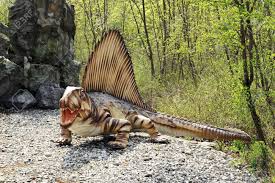
Dimetrodon Dinosaur is a prehistoric reptile belonging to the Permian period which occurred approximately 286 million to 248 million years ago. During this time, Dimetrodon was the apex predator, dominating the Central North American region. The creature stood in sharp contrast to modern day reptiles, with a mouth full of sharp teeth and a large sail-like structure on its back. It was originally classified as a dinosaur, but more recent evidence has led many to believe it was actually more closely related to mammals and therapsids.
Dimetrodon measured approximately 10-12 feet in length and weighed up to 500 pounds. It had a long, heavily muscled body, long tail and four small, stocky legs. The most distinguishing features of Dimetrodon were the spines on its back that connected to a large fin-like structure. This sail served as a way to regulate the creature's temperature by either soaking up sunlight in the cold or dissipating heat in the hot.
Dimetrodon Facts :
| Name: | Dimetrodon Dinosaurs |
| Size: | 10-12 feet |
| Main Facts: | Dimetrodon fed mainly on fish, amphibians, insects and other small animals. |
It used its sharp teeth to tear through flesh and was one of the most efficient predators of its time. The sail on its back was used primarily for intimidation purposes, allowing the predator to show its size and ferocity without necessarily having to attack. Fossils of Dimetrodon have been found all over the United States, but are most prolific in Texas, particularly in the Glen Rose Formation. Here, many of the creatures lie in almost complete sleeping postures, with their heads tucked into their bodies and their long spines protruding. This suggests that Dimetrodon most likely spent long periods resting in between feeding.
The Dimetrodon is one of the more fascinating creatures to have ever existed. Despite commonly being mistaken for a dinosaur, this creature proved to be a highly effective predator of the early Permian period, dominating the Central North American continent. Its sail-like structure made it adaptable to the heat and cold, while its sharp teeth and intimidating size kept small creatures and rival predators alike at bay. Its fossils remain some of the most fascinating specimens to this day.